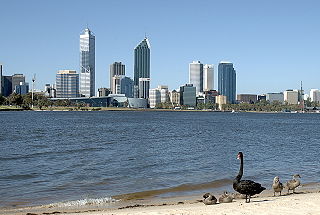
The Swan River is a river in the south west of Western Australia. The river runs through the metropolitan area of Perth, Western Australia's capital and largest city.

Fremantle is a port city in Western Australia, located at the mouth of the Swan River in the metropolitan area of Perth, the state capital. Fremantle Harbour serves as the port of Perth. The Western Australian vernacular diminutive for Fremantle is Freo.

Charles Yelverton O'Connor,, was an Irish engineer who is best known for his work in Western Australia, especially the construction of Fremantle Harbour, thought to be impossible, and the Goldfields Water Supply Scheme.

Toronto Harbour or Toronto Bay is a bay on the north shore of Lake Ontario, in Toronto, Ontario, Canada. It is a natural harbour, protected from Lake Ontario waves by the Toronto Islands. Today, the harbour is used primarily for recreational boating, including personal vessels and pleasure boats providing scenic or party cruises. Ferries travel from docks on the mainland to the Islands, and cargo ships deliver aggregates and raw sugar to industries located in the harbour. Historically, the harbour has been used for military vessels, passenger traffic and cargo traffic. Waterfront uses include residential, recreational, cultural, commercial and industrial sites.

Perth Water is a section of the Swan River on the southern edge of the central business district of Perth, Western Australia. It is between the Causeway to the east, and Narrows Bridge to the west – a large wide but shallow section of river, and the northern edge of the suburb South Perth. It is considered a landmark of the City of Perth.

South Fremantle is a suburb of Perth, Western Australia, located within the City of Fremantle.

Challenger Harbour is a marina in Fremantle, Western Australia adjacent to the Fremantle Fishing Boat Harbour. The harbour breakwater covers the historical site of the Fremantle Long Jetty.

Fremantle Harbour is Western Australia's largest and busiest general cargo port and an important historical site. The inner harbour handles a large volume of sea containers, vehicle imports and livestock exports, cruise shipping and naval visits, and operates 24 hours a day. It is located adjacent to the city of Fremantle, in the Perth metropolitan region.

The H class was a class of two steam locomotives operated by the Western Australian Government Railways (WAGR) introduced in 1889.

Howard Smith Wharves is a heritage-listed wharf on the Brisbane River at Boundary Street, Brisbane City and Fortitude Valley, City of Brisbane, Queensland, Australia. It was built from c. 1934 to 1940s circa. It is also known as Brisbane Central Wharves. The 3.5-hectare (8.6-acre) site is one of the most culturally and historically significant riverfront locations in Brisbane. It was added to the Queensland Heritage Register on 4 February 1997.

Fremantle Long Jetty was constructed in 1873 to replace the smaller South Jetty which had become too small for the large amounts of vessels entering the colony in Western Australia. The jetty lies in Bather's Bay which has been an occupation site since the Swan River Colony was established in 1829. It was a centre of trade and communications that served Fremantle and Perth until Fremantle Harbour was opened. An increased amount of shipping made it necessary to improve the harbouring facilities by the late 1860s. Long Jetty was built as a less expensive alternative to building a harbour at the mouth of the Swan River due to a lack of funds and technological shortcomings.

Bathers Beach, also known as Whalers Beach, is a section of coastline that has a written history since the European settlement of what is now called Fremantle, Western Australia.
The Black Swan was the first bucket dredge used by the Swan River Colony to make its rivers more suitable for shipping. The dredge was operational from 1872 to 1911, when it was scuttled. Initially known as the Government Dredge, it was renamed after being repaired and modified between 1887 and 1888. The dredging carried out by the Black Swan and other vessels had a significant impact on the river fauna and flora, including the black swans for which it was named.

The Fremantle Passenger Terminal was built on Victoria Quay, Fremantle in 1960–62, The construction replaced the former cargo sheds located at the site of construction.

Arthur Head in Fremantle, Western Australia, is a former large limestone headland on the southern side of the mouth of the Swan River, now also the entry to Fremantle Harbour.

Port Kembla is a man-made cargo port or artificial harbour, with an outer harbour protected by breakwaters and an inner harbour constructed by dredging, located in the Illawarra region of New South Wales, Australia.

E Shed Markets is a weekend market located on Victoria Quay in the Fremantle Harbour in Western Australia. It is housed in a historic timber building known as "E" Shed that was constructed in 1929 further up the quay and closer to the wharf. The building is one of a number of sheds that had varying names and locations in the twentieth century.

Rous Head is a reclaimed seabed area, which is utilised as a service industrial area. It includes a small harbour area that is located on the north side of the North Mole at Fremantle Harbour.

The Fremantle Outer Harbour is the part of Fremantle Harbour located in the Cockburn Sound, at the City of Kwinana, Western Australia. Fremantle Harbour consists of the Inner Harbour, which is situated on the mouth of the Swan River; and the Outer Harbour, which is 20 km to the south. It is managed by the Fremantle Port Authority.



















